<< Previous | Displaying results 6551-6600 of 6768 for "" | Next >>
A notice posted on a wall in San Francisco, California, lists “evacuation” instructions for the area’s Japanese American residents, 1942. They were deported, first to temporary “assembly centers,” and from there to relocation centers in remote areas of the United States.
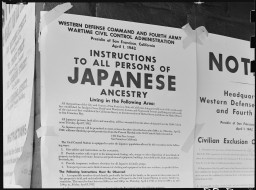
Army Military Police guarding the boundaries of the Manzanar Relocation Center in California, one of ten relocation camps where American residents of Japanese ancestry were forcibly deported, April 2, 1942.
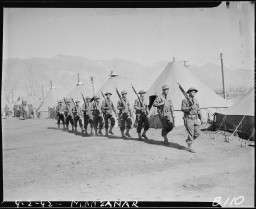
Japanese Americans hold a town hall meeting at the Manzanar Relocation Center in California, 1943.
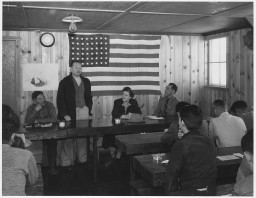
A group of nursery school children at the Heart Mountain Relocation Center in Wyoming, January 4, 1943. The Heart Mountain Relocation Center was one of ten relocation centers where Japanese Americans were forcibly deported.
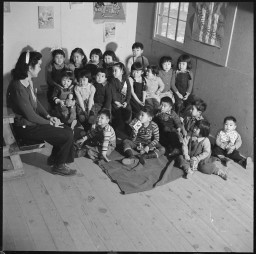
World War I (1914–18) saw the first use of poison gas as a weapon of war. In this oil painting, John Singer Sargent depicted the aftermath of a mustard gas attack on British soldiers during a battle in August 1918. A line of soldiers, with bandaged eyes injured by the gas, hold on to one another as they are led to medical treatment. Around them are rows of other soldiers injured by the effects of the mustard gas, which could cause injuries such as burns and temporary blindness. © IWM (Art.IWM ART…

Scene of destruction during World War I: panoramic view of the battlefield at Guillemont, September 1916, during the Battle of the Somme. © IWM (Q 1281)

Houses along the River Meuse damaged during the Battle of Verdun, December 1916. The battle was one of the longest and deadliest of World War I. © IWM (Q 67594)
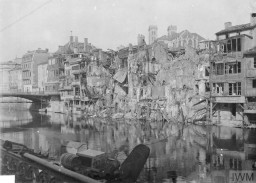
Surrounded by destruction, US soldiers of the 23rd Infantry fire a gun during World War I, 1918.
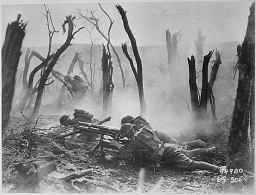
British troops in a trench cover the bodies of two fellow soldiers killed during the Battle of the Somme, November 1916. © IWM (Q 4393)
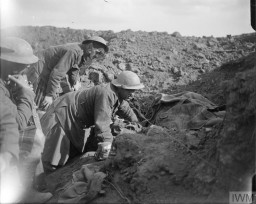
The first German troops to return from the conquests of Poland and France march through the Brandenburg Gate. Berlin, Germany, July 1940.
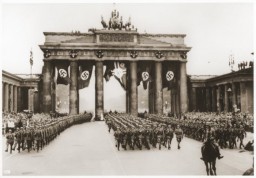
This photograph shows a group of SS officers at Solahütte, the SS retreat outside of Auschwitz. Pictured from left to right: Richard Baer, Dr. Josef Mengele, and Rudolf Höss. From Karl Höcker's photograph album, which includes both documentation of official visits and ceremonies at Auschwitz as well as more personal photographs depicting the many social activities that he and other members of the Auschwitz camp staff enjoyed. These rare images show Nazis singing, hunting, and even trimming a Christmas…
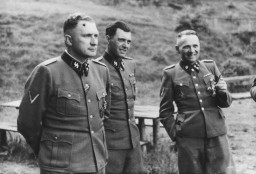
Adolf Hitler tasked Philipp Bouhler, the director of his private office, and Karl Brandt with co-leading the “euthanasia” program.
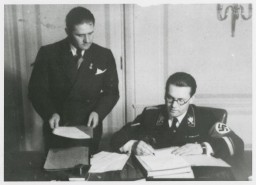
SS troops lead a group of Poles into the forest near Witaniow for execution. Witaniow, Poland, October–November 1939.

Execution of Polish prisoners of war near Ciepielow in September 1939. Some of the 300 Polish POWs who were executed here by firing squad are visible. In the background is a Wehrmacht soldier who participated. Ciepielow, Radom, Poland, September 1939.

The execution of Poles in the Barbarka Forest by members of the Selbstschutz (ethnic German self-defense organization). An SS officer can be seen standing in the background. Torun, Bydgoszcz, Poland, October 1939.
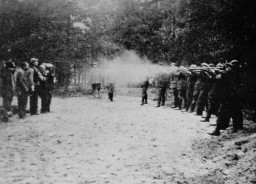
The execution of Polish civilians by the Selbstschutz (ethnic German self-defense organization) and SS in the forest near Tuchola. Bydgoszcz, October 27, 1939.
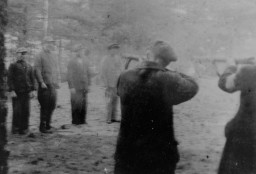
An SD officer reads a list of charges against a group of Polish civilians just before their execution in the forest near Szubin. A German soldier can be seen in the left background and a woman is included in the number of those to be shot. According to the Main Crimes Commission, one of the officers involved is SS Major Ernst Tiedemann. Szubin (Bydgoszcz), Poland, October 21, 1939.
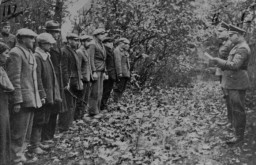
Polish civilians under SS and Selbstschutz (ethnic German self-defense organization) guard are forced to dig a mass grave prior to their execution in the forest near Tuchola. Tuchola Forest, Bydgoszcz, Poland, October 27, 1939.
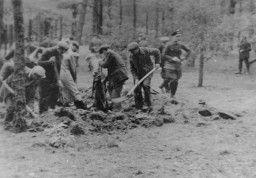
Teachers from Bydgoszcz and the surrounding area a few moments before their execution by firing squad in the "Valley of Death" near Fordon. The first in line is Wladyslaw Bielinski, a primary school teacher from Wiag. The Nazis sought to destroy Polish culture and the Polish nation, and eliminate any resistance, by arresting and murdering Poles. German police, SS, and army units and ethnic German “self-defense” forces shot thousands of Polish civilians. Among those shot were wealthy landowners, some…
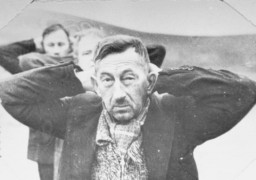
Polish women from the Pawiak and Mokotow prisons in nearby Warsaw are led into the Palmiry forest for execution by SS personnel.The original caption reads: "Their Nazi executioners leading a group of Polish women, according to the information attached to this picture which was just received through Polish sources. Hundreds of cvilians, men, women and even young children are said to be systematically 'eliminated' under the Nazi scheme of things in war-torn Poland". Palmiry Forest, Poland,…
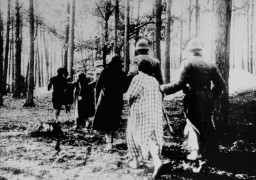
Members of the Zoska battalion of the Armia Krajowa stand atop a German tank captured during the 1944 Warsaw uprising. The tank was used by the battalion during its capture of the Gesiowka concentration camp. Warsaw, August 2, 1944.
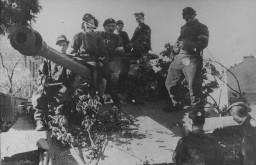
A member of the Zoska battalion of the Armia Krajowa escorts two of 348 Jews liberated from the Gęsiówka concentration camp during the Warsaw Polish uprising. August 5, 1944.
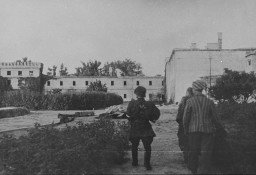
Soldiers of the Polish Home Army (Armia Krajowa) take cover behind a barricade during the Warsaw Polish uprising. During the uprising, the Home Army was supported by 2,500 soldiers from other resistance movements, such as the National Armed Forces (Narodowe Siły Zbrojne, NSZ) and the communist People's Army (Armia Ludowa, AL). Only a quarter of the partisans had access to weapons, fighting against 25,000 German soldiers equipped with artillery, tanks, and air forces. Two of the three soldiers shown here…
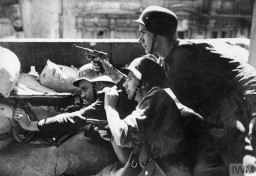
Soldiers of the Polish Home Army Women's Auxiliary Services, taken captive by the Germans in October 1944 as a result of the Warsaw Polish uprising. After the uprising ended on October 2, the Germans took as prisoners of war more than 11,000 soldiers of the Polish Home Army.

Planned as a short military revolt, the Warsaw Polish uprising lasted 63 days, from August to October 1944. In the end, German troops destroyed the majority of Warsaw during and immediately after the uprising. Photo dated January 17, 1945.
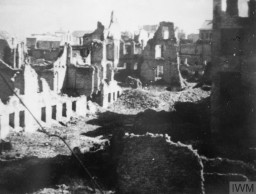
Soldiers from the Kiliński Battalion of the Polish Home Army take a German prisoner during the Warsaw Polish uprising. August 20, 1944.
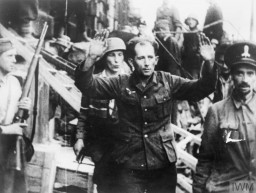
Following the German invasion of Poland on September 1, 1939, Warsaw suffered heavy air attacks and artillery bombardment. German troops entered the city on September 29, shortly after its surrender. This photograph was taken by Julien Bryan, an American documentary filmmaker who captured the German bombardment and its impact on the Polish citizenry. Warsaw, Poland, ca. 1939.
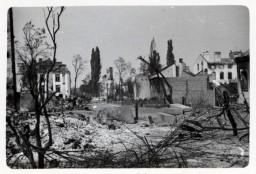
Members of a Polish family perform daily chores amidst the amidst the charred ruins of their home, destroyed during the German bombing of Warsaw. They have reassembled the remnants of their household furnishings outside. Photographed by Julien Bryan, circa 1939.
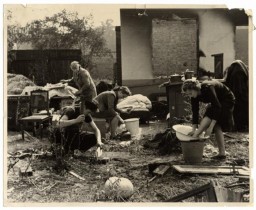
Polish children wander through the ruins of Warsaw after a German bombing. Photographed by Julien Bryan in Warsaw, Poland, ca. 1939.
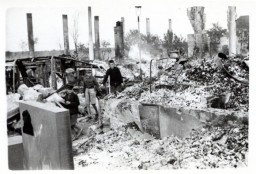
A ten-year-old Polish girl, Kazimiera Mika, mourns the death of her older sister, who was killed in a field in Warsaw, Poland, during a German air raid. Photographed by US documentary filmmaker, Julien Bryan, on September 13, 1939.

Father Wlodarczyk attempts to clean and repair a bombed-out church in the besieged city of Warsaw. Photographed by Julien Bryan, Warsaw, Poland, ca. 1939.
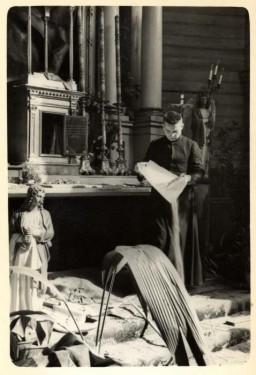
American judge Benjamin Barr Lindsey and his wife on a ship. Judge Lindsey's writings were among the texts the Nazis singled out during the 1933 public burnings of books. Photo dated December 4, 1915.
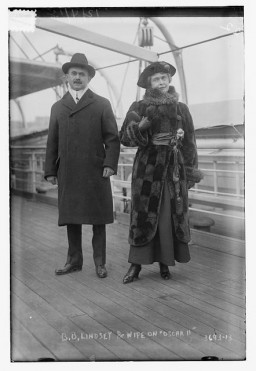
Portrait of American journalist John Reed, circa 1914. Reed's book Ten Days that Shook the World was among the texts Nazi students burned in 1933.
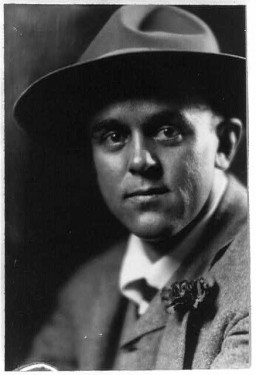
Born in Riga, Morris Hillquit became a prominent theoretician of the socialist movement after immigrating to the United States. The German translation of his work Socialism in Theory and Practice was burned in Nazi Germany in 1933. Photo taken circa 1910–1915.
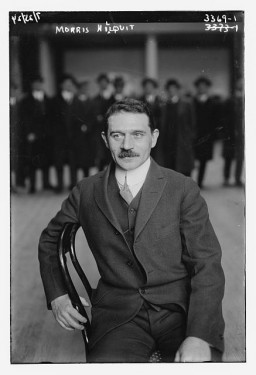
Nazi-produced propaganda slide entitled "Leading Figures of the System." The image was presented during a lecture called "Jewry, Its Blood-based Essence in Past and Future," Part I in a series on Jewry, Freemasonry, and Bolshevism. Germany, circa 1936. The slide features the portraits of six prominent Jewish political and cultural figures in Weimar Germany. Georg Bernhard, Rudolf Hilferding, and Walther Rathenau were among the authors whose works were targeted during the 1933 Nazi book burnings.
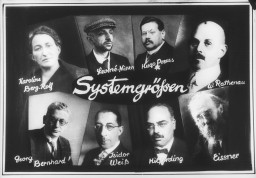
Portrait of writer Sigrid Undset, who won the Nobel Prize for Literature in 1928. Often with feminist themes, her novels were banned and burned in part because of her public criticism of the Nazi regime. Photo taken by Anders Beer Wilse on July 1, 1923.
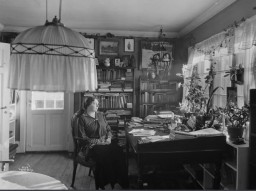
Sigrid Undset's novels were among the texts the Nazis banned and burned. Undset had previously won the Nobel Prize for Literature in 1928.
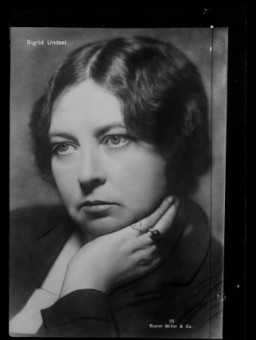
Vladimir Lenin was the leader of a faction of Russian communists known as the Bolsheviks. After the Russian Revolution broke out in 1917, Lenin seized control and established the Soviet Union. Photographed circa 1920. The Nazis had declared themselves the sworn enemies of Bolshevik Russia, its architect and dictator Vladimir Lenin, and his successor Josef Stalin.
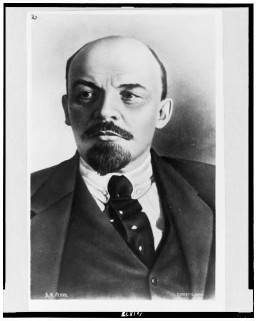
Foreign Minister of Germany from 1938 to 1945, Joachim von Ribbentrop sits in his cell during the Nuremberg trials. Photographed circa November 20, 1945 – October 01, 1946.
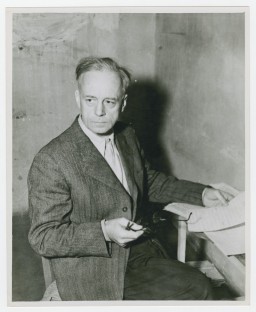
Propaganda slide for a Hitler Youth educational presentation entitled "German Achievements in the East." Circa 1934–1937.
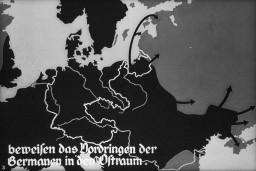
Newly arrived prisoners are assembled in the Appellplatz (roll call area) at the Melk camp, a subcamp of Mauthausen in Austria. 1944–45.
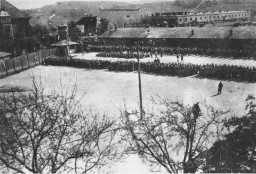
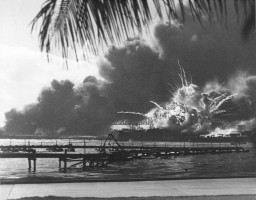
Psychiatric patients are evacuated to clinics where they will be murdered as part of the Nazi Euthanasia Program. Photo taken in Germany and dated circa 1942–1944. The term "euthanasia" usually refers to causing a painless death for a chronically or terminally ill individual who would otherwise suffer. In the Nazi context, however, "euthanasia" was a euphemistic or indirect term for a clandestine murder program that targeted individuals with physical and mental disabilities.
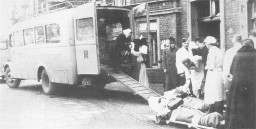
Nazi propaganda depicting two racial portraits of individuals considered non-Aryan. The original caption reads: "Then these are barely recognizable as human beings." Circa 1933–1943.
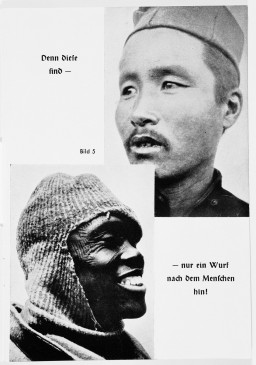
A segregated drinking fountain on the county courthouse lawn in Halifax, North Carolina. Photographed by John Vachon in April 1938.
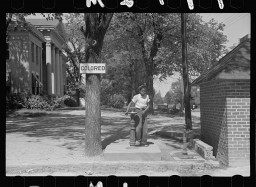
The Ku Klux Klan marches down Pennsylvania Ave in Washington, DC. Photograph by Harris & Ewing, 1926.

Cartoon depicting the United States' response to the refugee crisis in Europe, as well as the racism and discrimination African Americans faced at home. The Pittsburgh Courier, April 16, 1938. Page 10. Domestic concerns in the United States, including unemployment and national security, combined with prevalent antisemitism and racism, shaped America's immigration policies, responses to Nazism, and willingness to aid European Jews.
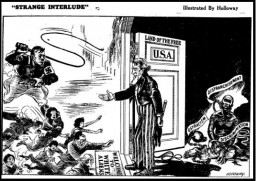
A German soldier guards a group of Poles and Jews who have been rounded-up and forced to stand in a line with their arms raised, Poland, September 1939.

German troops view the burning of a village in the Rogachyevo district of Gomel, Belarus, 1941.
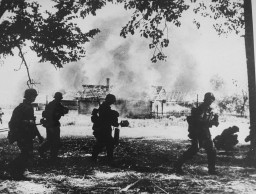
A German guard sitting on the end of a 20mm gun platform watches over 50,000 Soviet Prisoners of War (POWs) at Stalag 349, Ukraine, August 14, 1941.
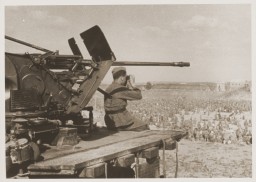
We would like to thank Crown Family Philanthropies, Abe and Ida Cooper Foundation, the Claims Conference, EVZ, and BMF for supporting the ongoing work to create content and resources for the Holocaust Encyclopedia. View the list of donor acknowledgement.